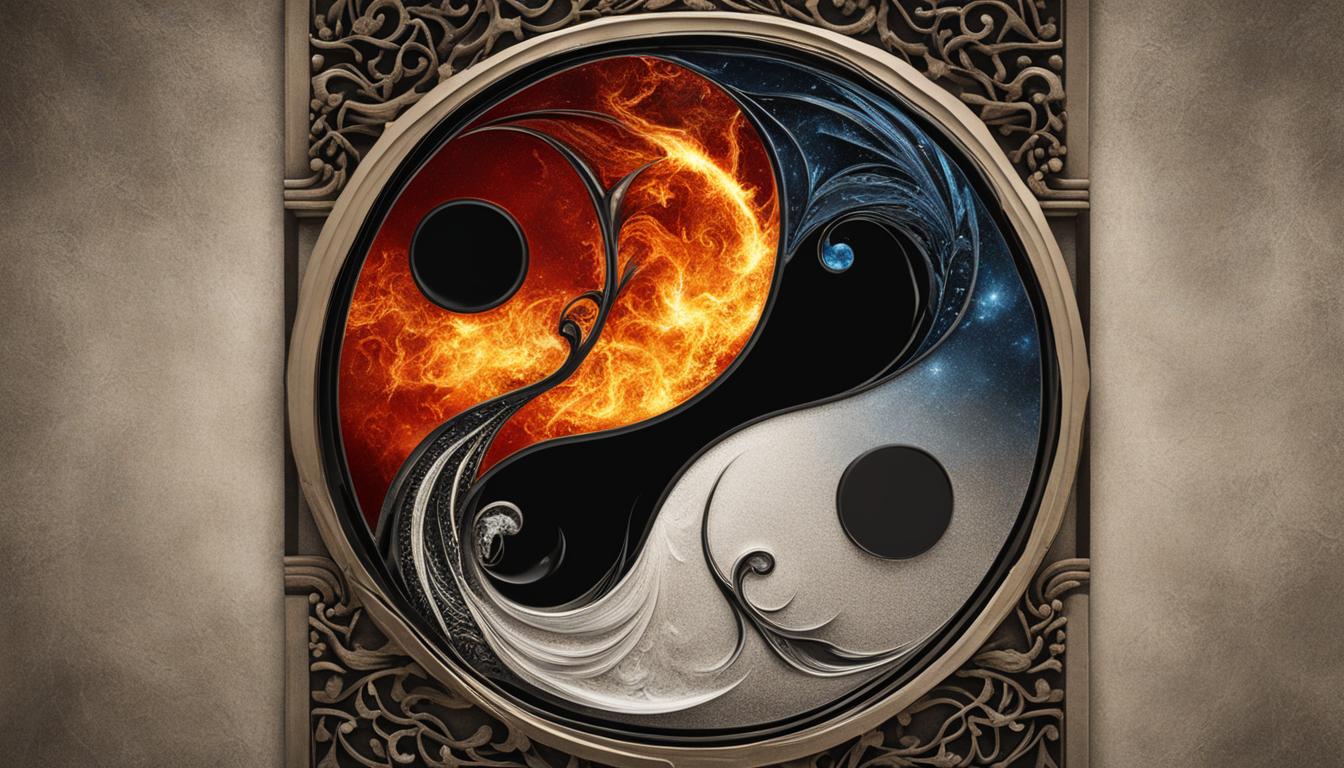The Yin and Yang symbol has gained popularity for its association with good luck. According to Chinese-born and New York-based designer Daisy Wang, the symbol is believed to help you balance the good and evil in your life. It is often used in jewelry and garments, symbolizing the harmony and balance of opposing forces. The concept of Yin and Yang dates back thousands of years, with roots in Chinese legend and mythology. It represents the idea that seemingly opposite forces in the world are not just complementary, but interdependent.
Contents
- 1 The Meaning and Interpretation of the Yin and Yang Symbol
- 2 The Cultural Importance of the Yin and Yang Symbol
- 3 Conclusion
- 4 FAQ
- 4.1 Does wearing the Yin and Yang symbol bring good luck?
- 4.2 What is the meaning and interpretation of the Yin and Yang symbol?
- 4.3 What cultural importance does the Yin and Yang symbol hold?
- 4.4 How is the Yin and Yang symbol associated with spirituality?
- 4.5 What does the Yin and Yang symbol represent in feng shui?
- 4.6 What is the conclusion about the Yin and Yang symbol?
- 5 Source Links
Key Takeaways:
- The Yin and Yang symbol is associated with good luck and is believed to help balance opposing forces in life.
- It represents the harmony and interdependence of seemingly opposite forces.
- The symbol has become a mainstream trend in fashion and is used by popular labels like Staud, Gelareh Mizrahi, Fenty x Puma, and Balenciaga.
- Yin represents dark, passive, and feminine qualities, while Yang represents light, active, and masculine qualities.
- The Yin and Yang symbol holds cultural significance in Chinese civilization and is widely used in practices like feng shui and Chinese medicine.
The Meaning and Interpretation of the Yin and Yang Symbol
The Yin and Yang symbol holds deep meaning and interpretation. It originated in ancient Chinese philosophy and is associated with the concept of balance and harmony. Yin represents dark, passive, and feminine qualities, while Yang represents light, active, and masculine qualities. The symbol represents the idea that these opposing forces are interconnected and complementary, and that one cannot exist without the other. The symbol is often interpreted as a representation of the duality in life, the constant interaction and interplay between opposing forces. It is believed to symbolize the harmonious balance between good and evil, light and dark, and other contrasting elements in the universe.
In Chinese culture, the Yin and Yang symbol is deeply ingrained in various aspects of life. It is not just a visual representation, but a philosophical concept that permeates Chinese belief systems, including Taoism and Buddhism. Many scholars and spiritual practitioners interpret the symbol as a reminder to embrace both light and dark aspects of oneself and to find harmony and equilibrium. It is a symbol of unity and interconnectedness, reminding individuals of the constant interplay and balance that exists in the world.
“The Yin and Yang symbol represents the interconnectedness of all things and the need for balance in life,” says Taoist master Liu Chengde. “It is a visual reminder to embrace both the light and dark aspects of our nature and to seek harmony and balance within ourselves and the world around us.”
The Yin and Yang symbol’s interpretation goes beyond philosophy and spirituality. It has also become a popular symbol in contemporary culture, representing the desire for balance and harmony in a fast-paced and often chaotic world. It has found its way into various forms of art, fashion, and design, captivating people around the world with its timeless appeal. Whether you wear a Yin and Yang pendant or simply appreciate it as a symbolic representation, the meaning and interpretation of the symbol continue to inspire and resonate.
| Yin | Yang |
|---|---|
| Dark | Light |
| Passive | Active |
| Feminine | Masculine |
| Soft | Hard |
| Cold | Hot |
The Cultural Importance of the Yin and Yang Symbol
The Yin and Yang symbol holds significant cultural importance in Chinese culture. It has been part of Chinese civilization since its inception and is deeply ingrained in various aspects of Chinese life. The symbol is widely used in feng shui, an ancient Chinese practice that aims to harmonize the energy flow in living spaces. In feng shui, the Yin and Yang symbol is believed to bring balance and positive energy to a space. It is also seen as a representation of the cyclical nature of life and the constant flow and change of energy. Additionally, the symbol is used in Chinese medicine, where it is associated with the balance of yin and yang energies within the body.
The Yin and Yang Symbol in Feng Shui
The Yin and Yang symbol plays a crucial role in feng shui, which is the ancient Chinese art of harmonizing energies in one’s environment. In feng shui, the symbol is used to create a balanced and harmonious space. The concept of yin and yang is applied to various aspects of life, including architecture, interior design, and even city planning. It is believed that by incorporating the Yin and Yang symbol into the design of a space, the energies can be balanced, promoting health, prosperity, and overall well-being. This is why you often see the Yin and Yang symbol in homes, offices, and other spaces that prioritize a harmonious environment.
The Symbolic Meaning of Yin and Yang in Chinese Culture
For centuries, the Yin and Yang symbol has been deeply intertwined with Chinese culture and philosophy. It represents the harmony and balance of opposing forces in the universe. In Chinese culture, the concept of yin and yang extends beyond the symbol itself and permeates various aspects of life, including relationships, food, and even personal attributes. The symbol is a reminder of the interconnectedness of all things and the need for balance in everything we do. It serves as a guide for living in harmony with oneself, others, and the natural world.
| Aspect | Examples |
|---|---|
| Food | Yin foods: fruits, vegetables, seafoodYang foods: meat, dairy, spicy food |
| Relationships | Yin qualities: gentleness, receptiveness, nurturingYang qualities: assertiveness, strength, ambition |
| Nature | Yin elements: earth, water, moonYang elements: fire, air, sun |
The Yin and Yang symbol is a reflection of the values and beliefs of Chinese culture, emphasizing the importance of balance and harmony. It serves as a powerful reminder to find equilibrium in all aspects of life and embrace the interdependence of opposing forces.

The Symbol of Balance
The Yin and Yang symbol is often seen as a representation of balance and harmony. It reminds us that life is a delicate equilibrium of opposing forces, and finding balance is essential for personal growth and spiritual development.
By incorporating the Yin and Yang symbol into their spiritual practices, individuals can cultivate a deeper understanding of themselves and the world around them. It serves as a powerful tool for self-reflection and introspection, allowing individuals to explore the dualities within their own nature.
| Benefits of the Yin and Yang Symbol in Spirituality | How to Incorporate the Yin and Yang Symbol in Your Spiritual Practice |
|---|---|
| Enhances awareness of inner balance and harmony | Place the symbol in your meditation space |
| Encourages acceptance of the light and dark aspects of oneself | Wear Yin and Yang jewelry as a reminder |
| Aids in aligning oneself with the natural flow of energy | Create a Yin and Yang altar with symbolic objects |
| Facilitates a deeper connection with the spiritual realm | Visualize the Yin and Yang symbol during meditation |
Whether you choose to incorporate the Yin and Yang symbol into your spiritual practice or simply appreciate its profound symbolism, it continues to inspire and captivate individuals on their spiritual journeys. Its enduring presence reminds us of the universal principle of balance and the interconnectedness of all things.
Conclusion
The Yin and Yang symbol holds significant cultural and spiritual importance, with various interpretations and beliefs surrounding its power and meaning. In Chinese culture, it is deeply rooted in tradition and is associated with balance, harmony, and the cyclical nature of life. The symbol is believed to bring good luck and positive energy to the wearer and is commonly used in feng shui to create a harmonious living space.
Moreover, the Yin and Yang symbol has transcended cultural boundaries and has become a mainstream trend in fashion and design. It is embraced by many for its aesthetic appeal and its representation of the interplay between opposing forces. Whether you wear the symbol as a fashion statement or incorporate it into your spiritual practices, it serves as a constant reminder to seek balance and find harmony within yourself and the world around you.
So, whether you believe in its mystical powers or simply appreciate its symbolism, the Yin and Yang symbol continues to captivate and inspire people worldwide. Its enduring popularity speaks to the universal desire for balance, luck, and positivity in our lives. Embrace the yin and yang, and discover the harmony and balance it can bring to your own personal journey.
FAQ
Does wearing the Yin and Yang symbol bring good luck?
According to Chinese beliefs, the Yin and Yang symbol is associated with good luck and is believed to help the wearer balance the good and evil in their lives.
What is the meaning and interpretation of the Yin and Yang symbol?
The Yin and Yang symbol represents the concept of balance and harmony. It symbolizes the interconnectedness of seemingly opposite forces and the constant interaction and interplay between them.
What cultural importance does the Yin and Yang symbol hold?
The Yin and Yang symbol holds significant cultural importance in Chinese culture. It is deeply ingrained in various aspects of Chinese life and is widely used in practices like feng shui and Chinese medicine.
How is the Yin and Yang symbol associated with spirituality?
In spiritual belief systems such as Taoism and Buddhism, the Yin and Yang symbol represents interconnectedness, balance, and the need for harmony in life. It is seen as a visual reminder to embrace both light and dark aspects of oneself.
What does the Yin and Yang symbol represent in feng shui?
In feng shui, the Yin and Yang symbol is believed to bring balance and positive energy to a space. It is seen as a representation of the cyclical nature of life and the constant flow and change of energy.
What is the conclusion about the Yin and Yang symbol?
The Yin and Yang symbol is deeply rooted in Chinese culture and holds various meanings and interpretations. Whether you believe in its powers or simply appreciate its aesthetic appeal, it continues to captivate and inspire people around the world.





